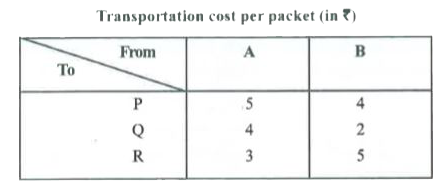There is a factory located at each of the two places P and Q. From these locations, certain commodity is delivered to each of the three depots situated at A, B and C. The weekly requirements of the depots are respectively 5, 5 and 4 units of the commodity while the production capacity of the factory at P and Q are respectively 8 and 6 units. The cost of transportation per unit is given below (Transportation problem)

How many units should be transported from each factory to each depot in order that the transportation cost is minimum? Formulate the above LPP mathematically.
The correct Answer is:Hence, the optimal transportation strategy will be deliver to 0,5 and 3 units from the factory at P and 5,0 and 1 units from the factory at Q to the depots at A,B, and C,respectively, Also the minimum transportation cost will be ₹ 155
Topper's Solved these Questions
- LINEAR PROGRAMMINGBOOK - ARIHANT PUBLICATIONCHAPTER - LINEAR PROGRAMMINGEXERCISE - QUSTIONS FOR PRACTICE (Manufacturing Problems)
2 Videos
- LINEAR PROGRAMMINGBOOK - ARIHANT PUBLICATIONCHAPTER - LINEAR PROGRAMMINGEXERCISE - QUSTIONS FOR PRACTICE (DIET Problems)
2 Videos
- INVERSE TRIGONOMETRIC FUNCTIONS BOOK - ARIHANT PUBLICATIONCHAPTER - INVERSE TRIGONOMETRIC FUNCTIONS EXERCISE - CHAPTER PRACTICE
35 Videos
- MATRICES BOOK - ARIHANT PUBLICATIONCHAPTER - MATRICES EXERCISE - CHAPTER PRACTICE (Very Short Answer Type Questions)
56 Videos
Similar Questions
(Transportation problem) There are two factories located one at place P and the other at place Q. From these locations, a certain commodity is to be delivered to each of the three depots situated at A, B and C. The weekly requirements of the depots are respectively 5, 5 and 4 units of the commodity while the production capacity of the factories at P and Q are respectively 8 and 6 units. The cost of transportation per unit is given below :

How many units should be transported from each factory to each depot in order that the transportation cost is minimum. What will be the minimum transportation cost?
View SolutionThere are two factories located one at place P and the other at place Q.From these locations, a certain commodity is to be delivered to each of the three depots situated at A, B and C. The weekly requirments of the depots are respectively 5,5 and 4 units of the commodity while the production capacity of the factories at P and Q are respectively 8 and 6 units. The cost of transportation per unit is given below:

How many units should be transported from each factory to each depot in order that the transportable cost is minimum? When will be the minimum transportation cost?
View Solution
Knowledge Check
Two particles P and Q are located at distance rpandrQ respectively form the centre of rotating disc such that rP>rQ. The disc is rotating with constant angular acceleration. We can say
ABoth P and Q have the same acceelerationBBoth P and Q do not have any accelcrationCP has greater acceleration than QDQ has greater acceleration than P
There are factories located one at place P and other at place Q from which a certin commodity is to be delivered to each of three depot situated at A,B and C. The weekly requirement of the depots are respectively 5,5 and 4 units of the commodity while the production capacity of the factories P and Q are respectively 8 and 6 units. The cost of transportation per unit is given below.

How many units should be transported from each factory to each depot in order that the transportation cost is minimum. Also find the minimum transportation cost.
View SolutionA medical company has factories at two places A and B. From these places supply is made to each of its three agencies situated at P, Q and R. The monthly requirements of the agen cies are respectively 40,40 and 50 packets of the medicines, while the production capacity of the factories A and B are 60 and 70 packets respectively. The transportation costs per packet from the factories to the agencies are given below:

View SolutionA medical company has factories at two places, A and B.From these places, supply is made to each of its three agencies situated at P,Q, and R.The monthly requirements of the agencies are respectively 40,40 and 50 packets of the medicines, while the production capacity of the factories A and B, are 60 and 60 packets respectively.The transportation cost per packet from the factories to the agencies are given below:

How many packets from each factory be transported to each agency so that the cost of transportation is minimum? Also find the minimum cost.
View SolutionP, Q and R are three collinear points. P and Q are (3, 4) and (7, 7) respectively, and PR =10 units. Find the coordinates of R.
View SolutionFind the average cost of production ( in Rs per unit ) in factories in two states.

View SolutionAn oil company has two depots A and B with capacities of 7000 L and 4000 L respectively. The company is to supply oil to three petrol pumps, D, E and F whose requirements are 4500L, 3000L and 3500L respectively. The distances (in km) between the depots and the petrol pumps is given in the following table:

Assuming that the transportation cost of 10 litres of oil is Re 1 per km, how should the delivery be scheduled in order that the transportation cost is minimum? What is the minimum cost?
View SolutionAn oil company has two depots A and B with capacities of 7000L and 4000L respectively. The company is to supply oil to three petrol pumps, D,E and F whose requirements are 4500L,3000L and 3500L respectively. The distances (in km) between the depots and the petrol pumpa is given in the following table:

Assuming that the transportation cost of 10 litres of oil is Rs. 1 per km, how shold the delivery be scheduled in order that the transportation cost is minimum? What is the minimum cost?
View Solution
